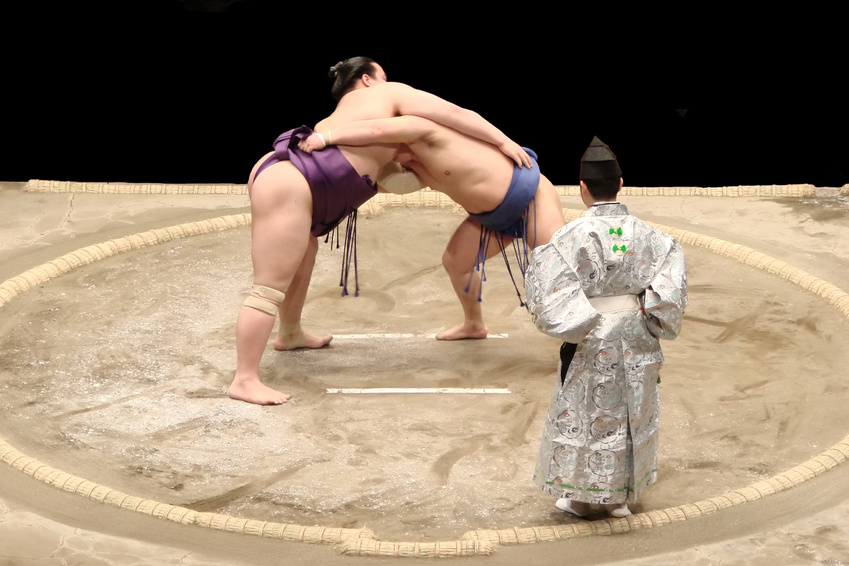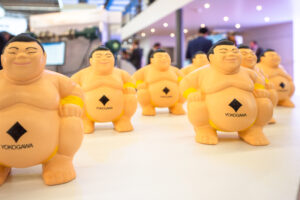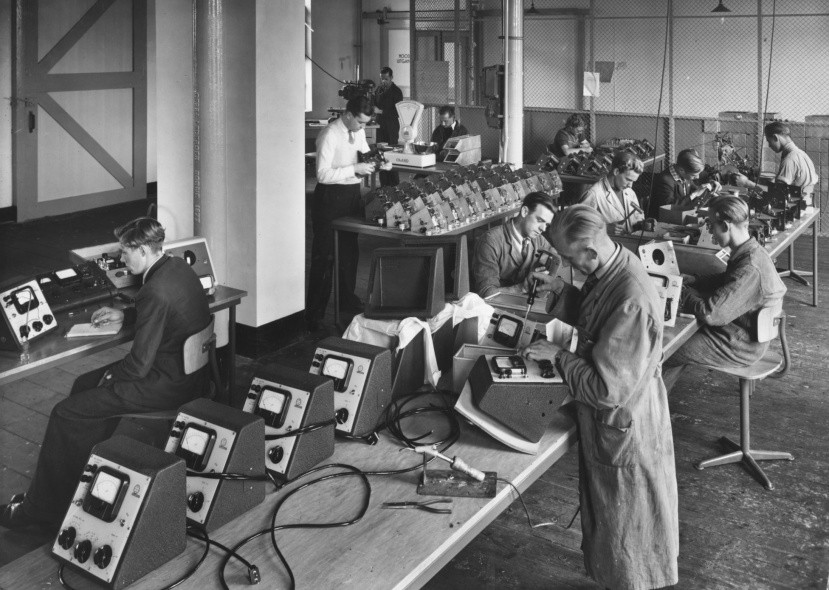A good two thousand of these small, soft giveaways changed hands in mid-June at the Yokogawa booth at the Frankfurt ACHEMA alone. Our stocks very soon ran out and we were unable to cope with the demand for these fat little men with their weird top-knot haircut and grotesque pants, which are actually a so-called “mawashi” belt – although we ought to be used to that by now. After all, these miniature sumo wrestlers are objects of desire, which have long been a firm fixture among Yokogawa’s promotional items and have proved hugely popular with customers at numerous events in the past in a variety of shapes and sizes.
The fascination and tradition that surround the real-life athletes on whom these little sumo dolls are modeled, and who frequently enjoy star status in Yokogawa’s home country of Japan, are even greater. Yet what are the origins of this martial art, fought out by huge, heavyweight wrestlers, and what lies behind the countless ceremonies and rituals that accompany sumo?
The history of sumo
No-one knows exactly how sumo started. However, one likely explanation is that the sport developed under Chinese or Korean influences. Both of these countries can look back on a long history of wrestling, and they both had a strong cultural influence during Japan’s early history.
Sumo was first mentioned in a document called the “Kojiki”, which dates from the year 712 AD and describes how the possession of the Japanese islands was determined by a wrestling match between the gods. The Chronicles of Japan (“Nihonshoki”), written just eight years later, included an account of the first sumo battle between mortals in 23 BC.
It appears that, slowly but surely, wrestling matches developed into a tradition at religious festivals prior to 500 AD. After the Japan Sumo Association reunited in 1926, the sport gradually became more and more commercialized and also more professional. Although many amateur leagues meanwhile exist worldwide, it is Japan that is home to the Ozumo, the only professional league system. Makuuchi, the top division of the Japanese sumo league, is the only one that is further divided into different weight classes – from maegashira through komusubi, sekiwake and ozeki to yokozuna, the titleholder or champion.
 The term “sumo”
The term “sumo”
The spoken word sumo has its origins in the verb sumau / sumafu, meaning to battle or compete. Sumo is also the generic Japanese term for wrestling.
Sporting venues and traditions
A tournament with more than 1500 wrestlers was organized in 1578. Circular boundaries called “dohyo” were drawn on the ground to prevent the contestants from getting in each other’s way. These evolved up until the 18th century into the modern dohyo, which is a circle of rice-straw bales 4.55 meters in diameter and mounted on a platform. Around the edge of the boundary is a strip of sand, so that it is easy to see when a wrestler steps outside. At the center are two white lines, behind which the wrestlers must position themselves at the start of a bout. All sumo bouts are overseen by a ring referee, who is supported by five side-judges.
A bout is over either when one contestant steps outside the ring or touches it in any other way or when one wrestler forces his opponent to touch the ground with any part of his body other than the bottom of his feet. The techniques employed by sumo wrestlers include pushing, flipping, throwing, slapping and frequently also outwitting. The Japan Sumo Association currently lists 82 different winning techniques. A single bout usually only lasts a few seconds and is far shorter than the ceremonial rituals that surround it.
Just like the centuries-old traditions, these rituals are an important part of any sumo event. The ring-entering ceremonies, for instance, are very impressive, as is the symbolic scattering of salt in the dohyo to purify it before the match.
Sumo wrestlers
Sumo wrestlers are referred to as sumotori or rikishi. The young men recruited to special sumo training stables, known as heya, are required to train and live there throughout their professional career. Not only the sport itself but every aspect of daily life is highly regimented from the outset, with rules regulated by the Japan Sumo Association. Even the clothes worn by sumo wrestlers are governed by strict etiquette. A young wrestler has his first sumo bout at around the age of 15, starting in the bottom division and working his way up. His career generally comes to an end somewhere between 30 and 40.
Apart from their physique, sumo wrestlers can also be recognized by their chonmage haircut, which is most commonly associated with the Edo period and samurai. Their traditional Japanese attire is similarly distinctive and is determined by their rank.
Great girth and body mass
Heavy body weight and a low center of gravity are considered to be the best physical qualifications for becoming a sumo wrestler. The typical picture of sumo wrestlers is therefore dominated by great girth and body mass. Their thick legs and hips are particularly emphasized along with their enormous bellies. To achieve this awesome physique and get their weight up to the necessary level, they eat and drink according to a special weight-gain diet throughout their entire career. The average weight of a sumo wrestler is currently around 150 kilograms. The heaviest wrestler ever in sumo was 2.04 meters tall and had an official weight of more than 320 kilograms. He allegedly peaked at 372 kilograms. Sumo wrestlers often suffer from joint problems or heart disease as a result of their massive weight. Yet extreme body mass is not enough on its own; a wrestler must also have a lot of explosive power and immense technical skills. Not only do they have exceedingly well-developed muscles; they are also very agile and they can all do the splits, among other things.
Depending on their rank (yokozuna being the highest), sumo wrestlers earn around 7500 to 20,500 euros a month. However, as soon as the protagonists start to climb the success ladder, their total income will probably be quite a bit higher what with prize money, bonuses and payments from sponsors.


 The term “sumo”
The term “sumo”

